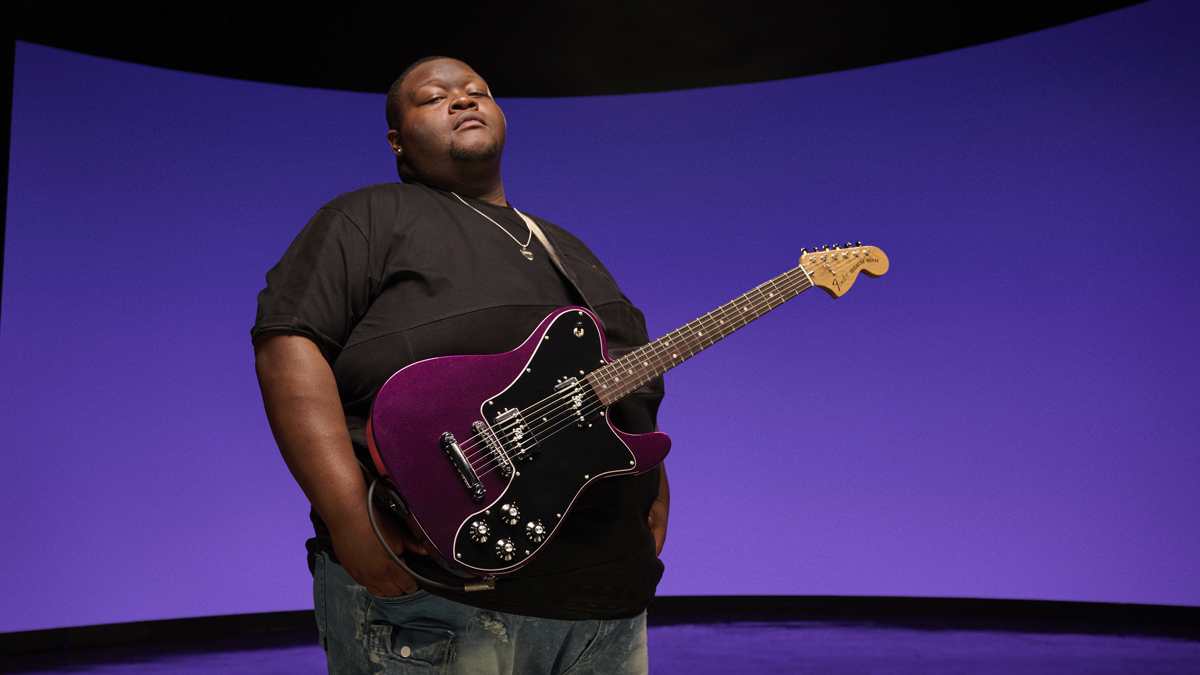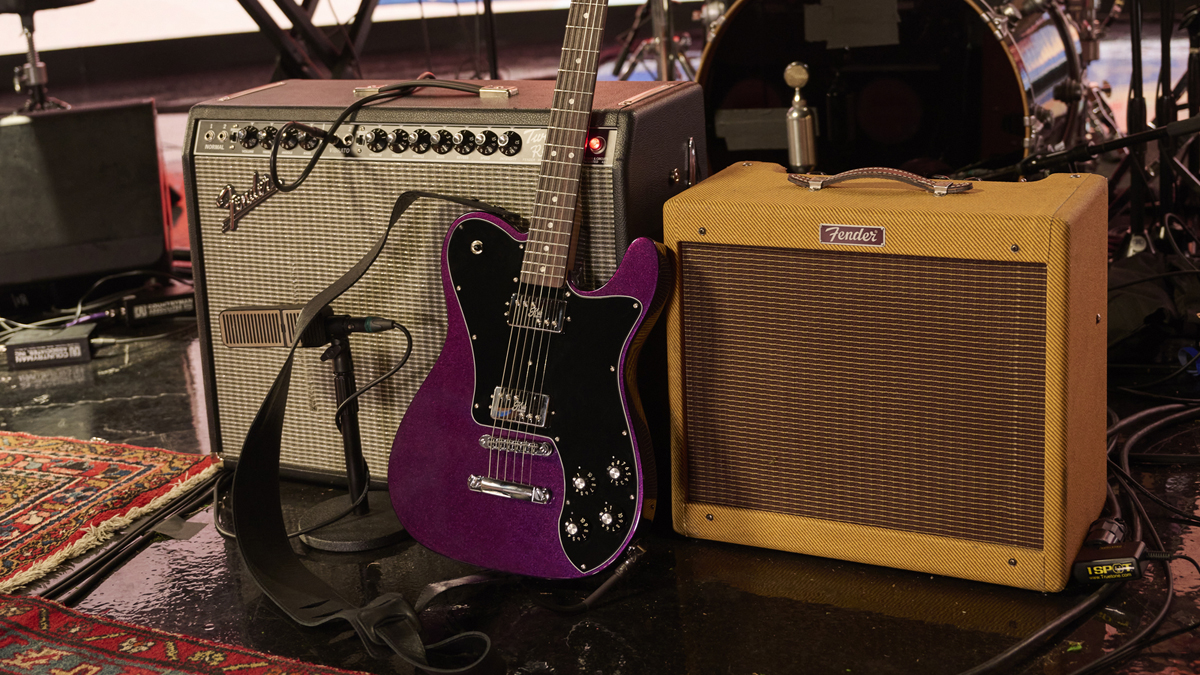Christone "Kingfish" Ingram: "You always want to say something when you play the blues, you always want to feel. You can’t play the blues by the book"
The Clarksdale, Mississippi native tells GW how he and Fender blended their ideas – deviating from '70s orthodoxy at times – to create his stylish and powerful new signature model

He’s the kind of player who can make people’s heads turn with just a few notes. Christone "Kingfish" Ingram has that rare quality that B.B. King had – the ability to imbue solos with weight and feeling, even when playing simple phrases.
However, the Clarksdale, Mississippi, bluesman is also a blisteringly effective player in the faster sections, too, never losing his phrasing when he’s laying down the notes thick and fast.
He’s used a wide range of electric guitars in the past few years, from custom electrics to Les Pauls and Strats. But it seems he’s finally settled down – teaming up with Fender to launch the Kingfish Telecaster Deluxe recently.
The guitar forms part of what seems like a minor resurgence for Fender’s 70s twin-humbucker single-cut, which had – it’s fair to say – languished among the company’s less widely used designs for many years.
Now, however, a Tele Deluxe forms a central model in Fender’s newly revamped American Vintage II range, announced this fall, and it’s well represented in Squier’s Classic Vibe and Fender’s flagship American Professional II ranges, too.

The key component of an original Tele Deluxe, its brace of CuNiFe-magnet Wide Range humbuckers, is no longer a given, however. The magnets went out of production for many years and Fender has only recently resurrected their use in authentic Wide Range replicas, which feature on the American Vintage II model.
One side effect of that scarcity, however, is that it’s become accepted that more conventional humbuckers will also work brilliantly on the Tele Deluxe platform, which – outside of the Parallel Universe series Troublemaker Tele guitars – represents Fender’s nearest approach to a Les Paul-style electric.
Get The Pick Newsletter
All the latest guitar news, interviews, lessons, reviews, deals and more, direct to your inbox!
Perhaps unsurprisingly, then, Ingram's signature Tele Deluxe moves it even further into traditional twin-humbucker single-cut territory, while retaining some quintessentially Fender elements.
We all mashed ideas together and that’s how the guitar came about
Christone "Kingfish" Ingram
The US-made Kingfish Telecaster Deluxe, which will set you back £2,249 in the UK, is clad in a striking Mississippi Night purple finish. A quick glance at the spec reveals further details that stray away from 70s orthodoxy, such as a Gibson-style intonation-adjustable bridge with a stopbar tailpiece and a roasted maple neck – the latter being a very on-trend way to increase neck stability, while lending the maple an attractive caramel tint.
While the neck has the expected 648mm (25.5-inch) Fender scale, the 305mm (12-inch) radius of the fingerboard tilts things back in a Les Paul-like direction. Less obviously still, the Custom Kingfish Humbucking pickups – while outwardly resembling Wide Range units – offer a rich, chunky classic humbucker tone that suits hot blues very well.
We join Ingram to find out more about the creation of his tailor-made electric and learn more about his sound and approach to blues…
How did the Kingfish Tele Deluxe project come about?
“Well, we started it 'round the time the pandemic was at its [height], so we all got on Zoom – me, my manager, a couple guys from Fender – and I told them what I wanted and we went through a couple of models [from Fender’s range of historic platforms] and all settled on the Tele Deluxe.
“Originally, I wanted to have something based off its Troublemaker Tele – you know, when they started doing the Les Paul-like features – so I wanted something of that nature. We all mashed ideas together and that’s how the guitar came about.”
You’ve used a variety of guitars up to now, including conventional Teles and Strats – what made you decide on a twin-humbucker format?
“I kinda just became primarily a humbucker player… I relaxed and [discovered] that’s where my sound is at. I tried Strats and other things, but that wasn’t me because I’m more a hard-hitting, humbucking guy. So I was trying to go to the classic sound.
“Like I said, humbuckers, overdriven, hard-hitting – you know, just straight. But I also want to be able to dial the volume back a little bit and turn the pedals off and get really good clean tones for jazz, R&B, gospel – the list goes on and on. That’s where we were going with the pickups.”

Tell us more about the pickups – you mentioned that they are versatile but how far do they go to covering the ground that a selection of electrics previously did?
“Well, I have a lot of music that calls for overdriven hard-rock sound. And I like to make the guitar scream in certain ways. So when it needs to do that, it does that. But on certain other songs, you can dial it back a little bit and play some smooth jazzy-type stuff that it does as well – it works perfectly for all that. I used to take another guitar on the road with me, but this [new Tele] has pretty much been the number one for me for the last couple of months.”
I wanted a V-shape neck – something that was not too big, not too thin, just right in-between, in the medium
What other elements of the Tele Deluxe design did you tweak to better suit your personal needs?
“I wanted a V-shape neck [profile] – something that was not too big, not too thin, just right in-between, in the medium. Not only that, I have an Adjusto-Matic bridge on there that’s [similar to] what you normally get on the Les Pauls, which was all about ‘comfortability’ for me. And I had the vintage-style tuners rather than new [locking] tuners – those were all things that I had picked out.”
Some blues players, such as Robben Ford, like their Telecasters set up on the high side so they can really dig into each note. How do you have the Kingfish set up – with a generous action or fast and low?
“Definitely low because low is more comfortable for me, especially because I use heavy strings: I like .11s. The low action from these is definitely better for my fingers – I can hit chords better. Even with the licks, I can hit licks better.”
What guitar amps will you be pairing the Kingfish Deluxe with?
“Yeah, it’s kind of a mixture, but I use primarily Fender Twins and Fender Hot Rod DeVilles. Or sometimes I use a Peavey Delta Blues or a Peavey Classic. I most definitely like a loud, clean punchy type of sound where I can get either the distortion or the cleanness.”
Those are traditionally high-headroom clean amps, so presumably you’re getting a lot of your drive tones from pedals. What are your go-to overdrives?
“I’m down to using one, but I went from a couple: from an MXR M294 Sugar Drive to the Way Huge [Smalls] Conspiracy Theory Professional Overdrive and then to the MXR M251 FOD [Marshall-style pedal based on the former Dookie drive]. I like a good overdriven natural sound when it comes to overdrives.”
What was your route into blues music as a younger man?
“Music has always been a part of my life in one way or another – I mean, I lived right next to a blues band. My mom’s side of the family, all of her uncles would get up to sing, so I was always around that. Clarksdale, Mississippi, is a blues city and I just fell into it that way. And that’s kind of how my interest in the guitar and instruments came about.”
Did you have any mentors on the local blues scene or direct influences? Who in particular caught your ear?
“Yeah, a lot of the older guys in the blues community back home, like T-Model Ford and Wesley "Junebug" Jefferson and Dr Michael James… all of these were known as bluesmen in the area that I was coming from, even some church guys as well. Definitely the local people in my area were a big influence on what I do.”
What’s your best advice for players who want to play better blues?
“As over-used as the term ‘feel’ is, feel has always been the number-one thing for me: you always want to say something when you play the blues, you always want to feel. You can’t play the blues by the book.”
The shredding is what got me most of my fanbase. So I have to manoeuvre that in a way, so I can shred here and there just to keep their attention
Often that means leaving a bit more space, choosing notes really judiciously. It can be really easy to over-play – so how do you achieve a good balance?
“Oh, yeah, I’ve been there. I’ve had my moments where I was being ‘shred’, when what I really had to learn was that you just gotta go back and study the masters. Were they doing it? Was Freddie King, Albert Collins and all these guys doing it? It all goes back to that feel thing.
“For me, I like to have a balance [between fast licks and slow, melodic sections] because here’s what it is: the shredding is what got me most of my fanbase. So I have to manoeuvre that in a way, so I can shred here and there just to keep their attention, but other times break it down to something with lots of feel that’s really bluesy.”
Are there any records that are musical touchstones for your style of playing?
“I’m not necessarily really into [specific] records, but Jimi Hendrix's Are You Experienced, a couple of B.B. King records, Indianola Mississippi Seeds and stuff like that. Even early Robert Johnson records, you know, anything of that nature: funk, blues, R&B…”
What’s coming next for you and the Kingfish Tele?
“The plan is to write more songs. I just got off a tour with Buddy Guy and I had a chance to sit and talk with [producer] Tom Hambridge. I’ve been on tour with him [Buddy Guy] three other times, so this was kind of like a family reunion, like coming back home. I got to hear more of his stories… it’s always a good time to soak up info from the OG [laughs]. So now the plan is to write more and record my music. As soon as we get done with touring, I’m just recording my music, man.”
Jamie Dickson is Editor-in-Chief of Guitarist magazine, Britain's best-selling and longest-running monthly for guitar players. He started his career at the Daily Telegraph in London, where his first assignment was interviewing blue-eyed soul legend Robert Palmer, going on to become a full-time author on music, writing for benchmark references such as 1001 Albums You Must Hear Before You Die and Dorling Kindersley's How To Play Guitar Step By Step. He joined Guitarist in 2011 and since then it has been his privilege to interview everyone from B.B. King to St. Vincent for Guitarist's readers, while sharing insights into scores of historic guitars, from Rory Gallagher's '61 Strat to the first Martin D-28 ever made.
“Such a rare piece”: Dave Navarro has chosen the guitar he’s using to record his first post-Jane’s Addiction material – and it’s a historic build
“The best guitar player I ever heard”: Nashville guitar extraordinaire Mac Gayden – who worked with Bob Dylan, Elvis, Linda Ronstadt and Simon & Garfunkel – dies at 83





![[from left] George Harrison with his Gretsch Country Gentleman, Norman Harris of Norman's Rare Guitars holds a gold-top Les Paul, John Fogerty with his legendary 1969 Rickenbacker](https://cdn.mos.cms.futurecdn.net/TuH3nuhn9etqjdn5sy4ntW.jpg)





